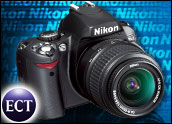
The proverb “he who hesitates is lost” may be true if you’re a member of the Danish aristocracy, but if you’ve been sitting on the fence about making a move from a point-and-shoot digital camera to a DSLR (digital single lens reflex) model, your hesitation may be rewarded.
Nikon has introduced a sweet DSLR unit, the Model D40, aimed at consumers who may have balked at the pricing and complexity of the current crop of byte-based, single-lens reflex cameras.
Although thin and pocketable digital cameras have a nice, nonthreatening quality about them, as an old SLR hand myself there is nothing as satisfying as caressing the grip of beautifully balanced, full-sized camera, even one as compact as the D40.
Car Without Tires
Tipping the scales at just over one pound (16.8 ounces), the D40’s 5 by 2.5 by 3.7 inch ebony body is 40 percent smaller than any Nikon DSLR to date.
Consumers who are unaccustomed to the SLR market may be confused by ads that list attractively low prices for a camera, only to find the phrase “body only” in the fine print. What? A camera without a lens? Isn’t that like selling acar without tires?
Nikon simplifies the D40 buying process by including a lens in the standard package — a Nikkor AF with an 18 to 55millimeter (mm) optical zoom (a 27-82.5 35mm equivalent). The F3.5 to F5.6 lens can be focused manually or automatically.
The camera will accept other Nikon lenses, but will only operate at full functionality with AF-S and AF-1 lenses. For example, the unit’s autofocus won’t work with Nikkor G and D lenses.
Gorgeous Photos
I found the lens included with the camera very versatile in a number of photo situations. The wide angle at the low end of the zoom range was terrific for indoor shots at family gatherings.
Photos taken with the D40 were drop dead gorgeous, with wonderful color fidelity. In addition, the camera’s focusing and exposure systems consistently produced sharp and correctly lit images.
Though the unit has a maximum resolution of six megapixels, the quality of its images were much better than some point-and-shoot cameras I have tried that offered higher resolutions. It does not capture video; however, you can view stills on a TV screen via a direct connection.
Three Display Formats
When moving from the point-and-shoot digital camera world to a DSLR, some degree of adjustment may be necessary, especially for point-and-shoot veterans who enjoy shooting photos using a digital camera’s LCD.
With DSLRs, you must shoot through the optical viewfinder. The LCD is strictly for reviewing photos, displaying information and making adjustments to the camera’s features — functions that the D40’s ample 2.5-inch display accommodates very well.
Reward For Patience
When showing information on its LCD, the D40 provides three display formats:
- The Classic View is chock full of info such as program mode, shutter speed, light sensitivity (ISO), aperture, battery strength and shots remaining.
- The Graphic View contains less information than the Classic View, but adds an on-screen graphical representation of the camera’s aperture. As I changed the camera’s exposure controls, the graphic mirrors the real-time movement of the aperture.
- The Wallpaper View is similar to the graphical view except the aperture graphic is missing and you can use a stored photo as a background for the LCD’s information screens.
Taking the D40 out of the box and using it immediately as a point-and-shoot camera is a simple operation, but accessing the finer points of the camera still requires reading the manual, which is lucid, indexed and has a very detailed table of contents, as well as an excellent frequently asked questions section.
He who hesitates is lost? Maybe. However, one man’s hesitation is another’s patience. Nikon has rewarded patience with anoutstanding camera that will make moving to the DSLR world irresistible for many digital shutterbugs.
John Mello is a freelance business and technology writer who can be reached at [email protected].





















































